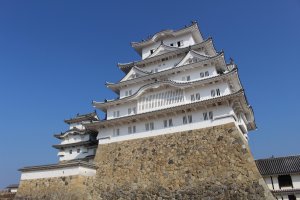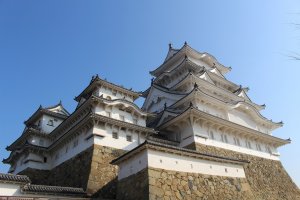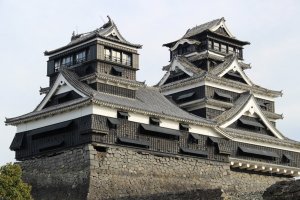Whilst hundreds of castles exist throughout Japan, the most popular castles are typically the greatest when it comes to scale, age and architectural prowess. Step forward two of Japan's most loved castles in Himeji Castle (Hyogo) and Kumamoto Castle (Kumamoto) – considered some of the best examples of a defensive fortress that can be seen in Japan today.
They both represent different styles too, with Himeji's white elegance a stark contrast to Kumamoto's fearsome black exterior. Here we explore each castle in greater detail, as well as discover the best of what the surrounding cities have to offer.
Himeji – in-depth

In central Japan's Hyogo prefecture, Himeji Castle has stood tall for over 400 years. Unlike many of Japan's castles, Himeji Castle is an original and, along with the castle grounds, has been well preserved over the years. It was the first location in Japan to be awarded UNESCO World Heritage status back in 1993 and is a designated national treasure. It is also known as the 'White Heron Castle' for its white external appearance and beauty and is one of the largest castles in Japan.
The castle grounds comprise numerous keeps, towers and gates throughout, with the 7-floor Main Keep (Daitenshu) the main draw in the heart of the complex. There is a huge range of distinctive architectural and technological features to delight visitors that truly showcase Japan's historical excellence in wood craftsmanship and artistry at the time. From the decorative bargeboards used in roof construction to Hongawarabuki-style tile-roofing, or myriad defensive features such as uniquely shaped loopholes and fan-shaped stone walls, the secrets and subtle curiosities of Himeji Castle are vast and impressive.
Visitors can enjoy a tour of the original structure across its 7 floors, as well as countless photo opportunities to be found around the castle grounds. Some of the best include the Nishi-no-maru vantage point to the south west of the Main Keep, and the Bizen Maru ‘courtyard’ towered over by the main keep.
Around Himeji
Visitors to Himeji have so much more to see though – including:
-
Koko-en, a collection of 9 traditional gardens including the tranquil Oyashiki-no-niwa – complete with central pond, Koi carp, waterfalls and decked walkways— and the Tea Garden, where you can witness tea ceremony and sample some matcha green tea at Souju-an.
-
Learn about the sake making process at the traditional Meiji-era wooden brewery of Nadagiku Sake Brewery. Try their feast of traditional, healthy Japanese foods infused with sake flavours from the brewery.
-
The covered arcades and shopping streets hide lots of small discoveries. Try the local 'almond toast' and siphoned coffee at Hamamoto Coffee, or stay at the friendly and affordable 588 Guesthouse on one of the arcade streets.
-
Discover some memorable views of Himeji Castle further away from the castle grounds, including from the rooftop observatory at the Egret Himeji department store (shown here). The rooftop of Piole Himeji and an observatory deck to the north of Himeji Station also provide glimpses of the castle – the latter great for the castle light-up in the evening.
Kumamoto – in-depth

Kumamoto Castle was built in 1607 by daimyo Kato Kiyomasa, a strong tactician and proven warrior, who designed the castle to be a defensive fortress and impregnable to opposing forces. Some of its defensive features include sloping Musha-gaeshi castle walls that were hard to scale, Shinobi-gaeshi iron spikes at the entrances, not to mention Kumamoto Castle's distinctive raven-black appearance. Other characteristics were more strategic – such as hundreds of wells across the castle grounds to help ensure survival under siege conditions.
Whilst some of the site's ancillary wooden constructions are the originals, the wider castle grounds have seen several periods of reconstruction throughout its lifetime. In the past, several structures were notably burned down during the Seinan Rebellion of 1877. In the modern day, the major earthquakes of April 2016 damaged a number of turrets and keeps. While restoration work is likely to continue for decades, the main keep is expected to re-open around 2019.
Although restoration work means entry inside the castles is not currently possible, a specially preserved observation route means that visitors can comfortably explore and are encouraged to make a trip to see one of Japan's best loved castles. All the keeps survived and stand proudly in defiance along the skyline. The best vantage point from which to see this is perhaps from the top floor of Kumamoto City Hall, to the south-east of the castle grounds.
The Josaien area located in Sakura-no-baba at the foot of the castle grounds to the south-west provides an old castle town feel with its souvenir shops and food stalls. With a Tourist Information Centre and good access, it provides a logical starting point for visitors to the castle and provides good views of the Hitsujisaru turret and Iidamaru Gokai Yagura turret (the latter sadly dwarfed by a steel bracket helping to safeguard it from collapse.)
Visitors can then continue up around the edge of the castle grounds via Ninomaru Park before reaching Kato Shrine, which provides a commanding view of the main keep and the Uto-yagura turret against the towering stone wall below.
Around Kumamoto
Visitors to Kumamoto have much to see around the town itself, including:
-
Discover all things Kumamon at Kumamon Square, the official shop for Kumamoto's official mascot and one of Japan's most well-known characters. Choose from a wide range of merchandise or visit Kumamon's very own office here!
-
Visit the secluded Reigan-do Cave located at the foot of Mt Kinpozan. This tranquil environment served as the backdrop for the famous samurai, Miyamoto Musashi, who spent several years later in life here writing his famed "The Book of Five Rings".
-
Stop by Wa Collection Mito before entering Suizenji Park. They'll suit you up in traditional kimono ready for a photo shoot then stroll around the park. Stopping by the Izumi Shrine and traditional tea house in kimono makes for a memorable experience, and don't forget to look out for some of the famous landmarks, such as the miniature Mount Fuji.
-
In the evening, why not try one of Kumamoto's most popular restaurants, Katsuretsutei, which serves tonkatsu pork cutlets. Then learn all about shochu at Glocal Bar Imo Vibes [permanently closed], where the energetic Nori-san shares his love for shochu and, if you're a beginner, take you through some recommended styles. Ramen is always another good late-night option for those still hungry – Kumamoto's local ramen style is famous for its modified tonkotsu base, with added garlic oil and fried garlic.
Both Himeji Castle and Kumamoto Castle provide stellar examples of some of the best Japanese defensive architecture across masonry and wood craftsmanship to be found in Japan.
They both represent contrasting styles in two very different regions of Japan, and are separated by just a couple of hours by bullet train.
Whilst you could easily cover both sites inside a day, both locations have much in the way of local culture to offer it would be worthwhile spending a couple of days in both locations to make the most of it.




























You know about these castles more than other young Japanese.
Amazing!!! Thank you!!!